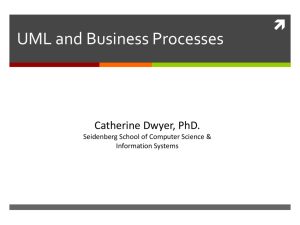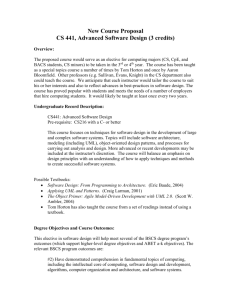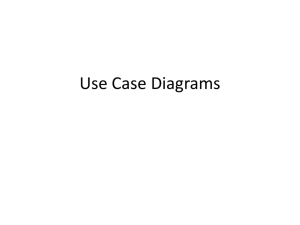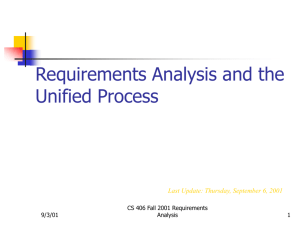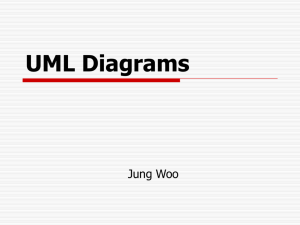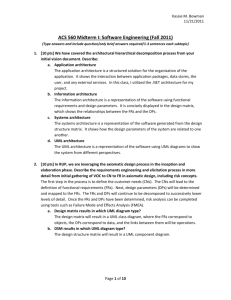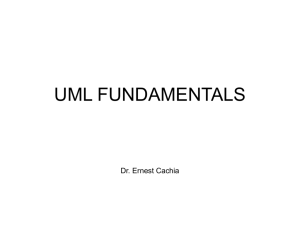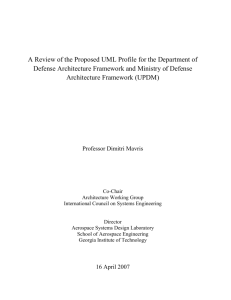Exam Questions
advertisement
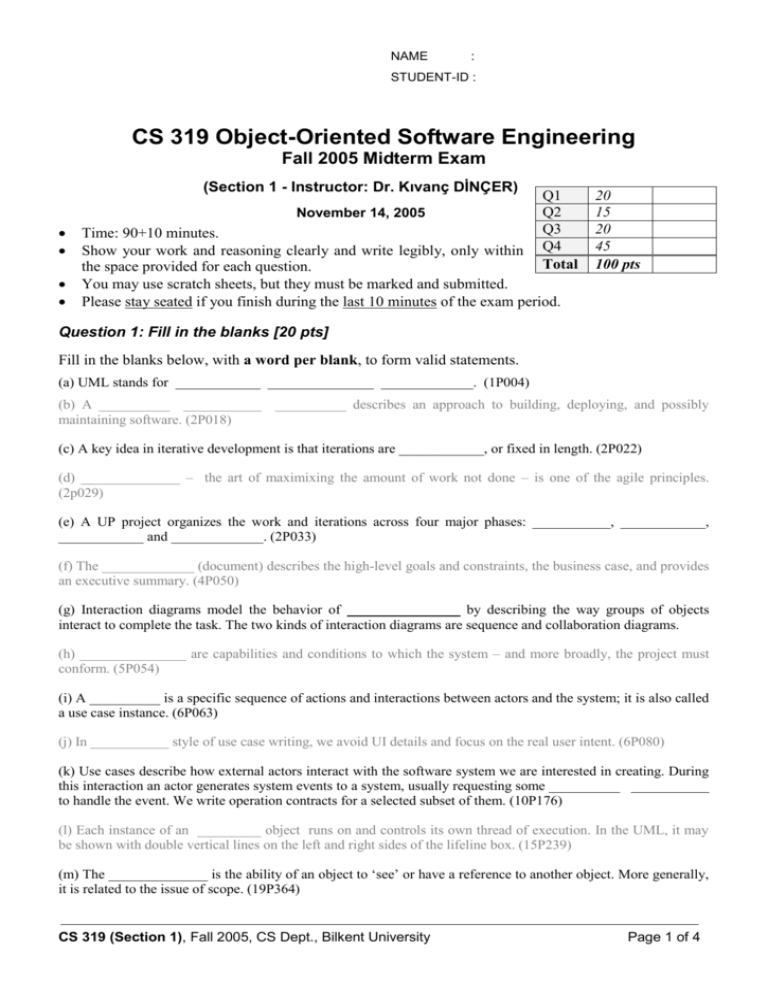
NAME : STUDENT-ID : CS 319 Object-Oriented Software Engineering Fall 2005 Midterm Exam (Section 1 - Instructor: Dr. Kıvanç DİNÇER) November 14, 2005 Q1 Q2 Q3 Q4 Total Time: 90+10 minutes. Show your work and reasoning clearly and write legibly, only within the space provided for each question. You may use scratch sheets, but they must be marked and submitted. Please stay seated if you finish during the last 10 minutes of the exam period. 20 15 20 45 100 pts Question 1: Fill in the blanks [20 pts] Fill in the blanks below, with a word per blank, to form valid statements. (a) UML stands for ____________ _______________ _____________. (1P004) (b) A __________ ___________ __________ describes an approach to building, deploying, and possibly maintaining software. (2P018) (c) A key idea in iterative development is that iterations are ____________, or fixed in length. (2P022) (d) ______________ – the art of maximixing the amount of work not done – is one of the agile principles. (2p029) (e) A UP project organizes the work and iterations across four major phases: ___________, ____________, ____________ and _____________. (2P033) (f) The _____________ (document) describes the high-level goals and constraints, the business case, and provides an executive summary. (4P050) (g) Interaction diagrams model the behavior of ________________ by describing the way groups of objects interact to complete the task. The two kinds of interaction diagrams are sequence and collaboration diagrams. (h) _______________ are capabilities and conditions to which the system – and more broadly, the project must conform. (5P054) (i) A __________ is a specific sequence of actions and interactions between actors and the system; it is also called a use case instance. (6P063) (j) In ___________ style of use case writing, we avoid UI details and focus on the real user intent. (6P080) (k) Use cases describe how external actors interact with the software system we are interested in creating. During this interaction an actor generates system events to a system, usually requesting some __________ ___________ to handle the event. We write operation contracts for a selected subset of them. (10P176) (l) Each instance of an _________ object runs on and controls its own thread of execution. In the UML, it may be shown with double vertical lines on the left and right sides of the lifeline box. (15P239) (m) The ______________ is the ability of an object to ‘see’ or have a reference to another object. More generally, it is related to the issue of scope. (19P364) CS 319 (Section 1), Fall 2005, CS Dept., Bilkent University Page 1 of 4 NAME : STUDENT-ID : Question 2: True – False [15 pts] Indicate whether you think the following are true or false. If you think an item is false, underline the incorrect part(s). Provide no explanations, and keep in mind that one incorrect answer cancels out a correct one. (a) True | False The proverb “owning a hammer doesn’t make one an architect” is especially true with respect to object technology. Knowing an object oriented language is necessary but insufficient first step to create object systems. Knowing how to “think in objects” is critical ! (1P004) (b) True | False During object-oriented design there is an emphasis on finding and describing the objects – or concepts – in the problem domain. (1P007) (c) True | False There are three ways people apply UML: UML as sketch, UML as blueprint, UML as programming language. Agile modeling emphasizes UML as a sketch. (1P012) (d) True | False Iterative and evolutionary software development process rely on quick development steps, feedback, and adaptation to clarify the requirements and design. (1P018) (e) True | False There is not one simple answer to why the waterfall software development process is so failure-prone, but it is strongly related to a key false assumption underlying many failed software projects – that the specifications are predictable and stable and can be correctly defined at the start, with low change rates. (2P024) (f) True | False We call an operation polymorphic, if the running program decides, every time an operation is called, which of several identically named methods to invoke. (L2P036) (g) True | False Use cases are requirements, primarily functional or behavioral requirements that indicate what the system will do. (6P065) (h) True | False An actor is anything with behavior, including the system under discussion itself when it calls upon the services of other systems. (6P066) (i) True | False A main success scenario of a use case describes a typical success path that satisfies the interests of the stakeholders. (6P074) (j) True | False A UP Domain Model often inspires objects and names in the UP Design Model. (9P138) (k) True | False A system sequence diagram is a picture that shows, for one particular scenario of a use case, the events that external actors generate, their order, and inter-system events. All systems are treated as a black box; the emphasis of the diagram is events that cross the system boundary from actors to systems. (10P176) (l) True | False The logical architecture is the large-scale organization of the software classes into packages, subsystems, and layers. (13P199) (m) True | False The UML interaction diagrams illustrate how objects interact via messages. They are used for static object modeling. (15P221) (n) True | False UML sequence diagrams are more space economical as compared to UML communication diagrams. (15P224) (o) True | False Singleton pattern implies that there is only one instance of a class instantiated. (16P266) CS 319 (Section 1), Fall 2005, CS Dept., Bilkent University Page 2 of 4 NAME : STUDENT-ID : Question 3: OOSE [20 pts] (a) In UP we depend on feedback and adaptation for success. Explain who give(s) that feedback and how? (2P025) (b) What does “managing requirements” mean? (5P054) (c) Why do we write a Vision document? What is our purpose? (7P111) (d) Why do we write operation contracts? What is their use? (11P189) CS 319 (Section 1), Fall 2005, CS Dept., Bilkent University Page 3 of 4 NAME : STUDENT-ID : Question 4: OOA/D and UML [45 pts] Consider the following problem description for a Police Information System: The system helps the police officers keep track of the work they are assigned to do. Officers may be assigned to investigate particular cases, to patrol particular areas or to attend particular events such as court cases. Some work assignments are regular ongoing assignments, while others are for a particular period of time. The system information is updated by the logistics administrator, but individuals officers have also an interface to display their assigned work. (a) (10 points) Draw the use case diagram for the above system. (b) (10 points) Derive the design class diagram for the above system. (c) (15 points) Choose the use case where the logistics administrator is the primary actor. Describe the pre- and post-conditions, main success scenario and the extensions for this use case. (d) (10 points) Draw the system sequence diagram for the above use case. Hint: Make sure that all your work is consistent with each other. - GOOD LUCK - CS 319 (Section 1), Fall 2005, CS Dept., Bilkent University Page 4 of 4




